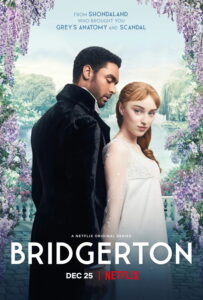by Sara Conway on February 11, 2021
Film and Television
by Nikki Idelson ’22 A&E Staff

Anyone who has been on Netflix recently has heard of the new show Bridgerton, which has been all the rage for almost two months now. The season first aired on Dec. 25, 2020, and has been in the top-10 list on Netflix ever since. According to The Today Show, the series is “based on the popular Bridgerton book series, written by Julia Quinn, that revolves around two families during ‘the season,’ an annual period where elite families would host formal events to introduce their children to society and find them a suitable marriage.” It takes place in England during the early 1800s and follows the scandalous lives of several families who are part of the elite.
Looking beyond all of the scandals, the show also incorporates a lot of important details about the gender roles that existed during the early 1800s. Anthony, the eldest Bridgerton, is asked by his mother in the first episode, “Are you merely the older brother, or are you the man of the house?” This question shows the patriarchal expectations that existed at the time, as men were expected to step up and be the leaders of their given households. Anthony was simply expected to take on this role of “man of the house” and arrange for his sisters to be married off, as he was the eldest of his brothers when their father died.
Bridgerton also shows the domestic roles that women, especially those of the upper class, were expected to have in society. Women were expected to be married off at a very young age to a man within their given social class. One character who fights against this norm is Eloise, one of the Bridgerton sisters. Eloise desires a life that does not simply revolve around marriage as she instead dreams of attending college. This dynamic can be seen in episode two when she says, “Having a nice face and pleasant hair is not an accomplishment. Do you know what is an accomplishment? Attending university! If I were a man, I could do that, you know.”
Looking at the gender roles that exist within society today, it is evident that women now have more freedom in deciding what they want to do with their lives, as well as who, and even if, they desire to marry. However, these classic gender roles are still apparent, as men are expected to be the heads of their households—in which they hold a job and are the only provider—while women are expected to be the nurturing caregivers who remain at home to take care of the children as well as the household. Even though a few of the show’s characters, such as Eloise, defy their expected gender roles, the majority eventually fall into these roles due to social pressures. Although these gender roles have dissolved in some capacity since the 1800s, they remain evident in today’s society.